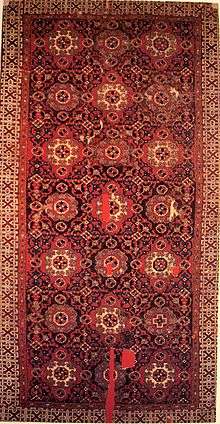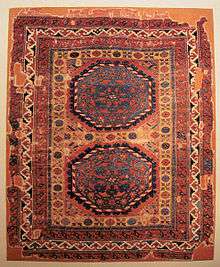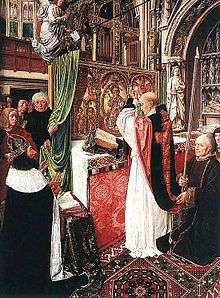Holbein carpet



Holbein carpet are a type of Ottoman carpets taking their name from Hans Holbein the Younger, due to their depiction in European Renaissance paintings. Actually, these in fact are seen in paintings from many decades earlier than Holbein, and are sub-divided into four types (of which Holbein actually only painted two); they are the commonest designs of Anatolian carpet seen in Western Renaissance paintings, and continued to be produced for a long period. All are purely geometric and use a variety of arrangements of lozenges, crosses and octagonal motifs within the main field. The sub-divisions are between:[1]
- Type I: Small-pattern Holbein. The motifs are small, and usually of several different types that recur regularly.[2]
- Type II: now more often called Lotto carpets.
- Type III: Large-pattern Holbein. The motifs in the field inside the border are large squares filled with decoration, placed regularly, with narrow strips between them containing no "gul" motifs. The carpet in Holbein's The Ambassadors is of this type.[3]
- Type IV: Large-pattern Holbein. The square compartments have octagons or other "gul" motifs from the small-pattern types between them.[4]
Holbein frequently used carpets in portraits, on tables for most sitters, but on the floor for Henry VIII.
 Verrocchio's Madonna with Saint John the Baptist and Donatus 1475-1483.
Verrocchio's Madonna with Saint John the Baptist and Donatus 1475-1483. Master of Saint Giles, Mass of Saint Giles, c. 1500, with a Type III Holbein carpet.
Master of Saint Giles, Mass of Saint Giles, c. 1500, with a Type III Holbein carpet. French ambassador to England Jean de Dinteville in "The Ambassadors", by Hans Holbein the Younger, 1533. This is a "large-pattern Holbein", Type III.
French ambassador to England Jean de Dinteville in "The Ambassadors", by Hans Holbein the Younger, 1533. This is a "large-pattern Holbein", Type III.
See also
![]() Media related to Holbein carpet at Wikimedia Commons
Media related to Holbein carpet at Wikimedia Commons
Notes
- ↑ King & Sylvester, pp. 26-27, 52-57. Campbell, p. 189.
- ↑ Old Ottoman carpets, see also last note.
- ↑ Old Ottoman carpets, Large-pattern Type III Holbein Carpets. See also note to the last paragraph.
- ↑ Old Ottoman carpets, Large-pattern Type IV Holbein Carpets. See also note to the last paragraph.
References
- Brown, David Alan, Peter Humfrey and Mauro Lucco Lorenzo Lotto: Rediscovered Master of the Renaissance, New Haven, Yale University Press, 1997.
- King, Donald and Sylvester, David eds. The Eastern Carpet in the Western World, From the 15th to the 17th century, Arts Council of Great Britain, London, 1983, ISBN 0-7287-0362-9
- Mack, Rosamond E., Bazaar to Piazza: Islamic Trade and Italian Art, 1300-1600, Los Angeles, University of California Press, 2002.